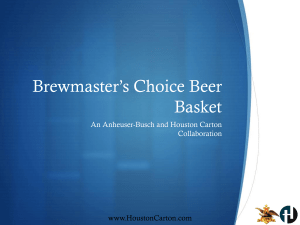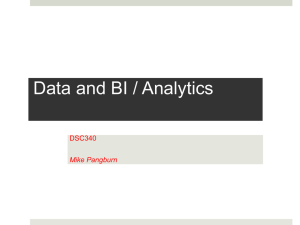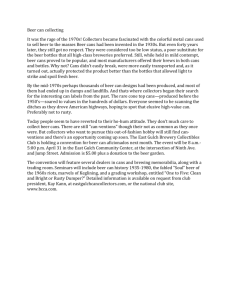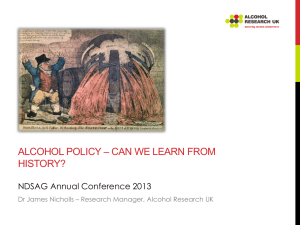記錄 編號 12137 狀態 G0498856037 助教 查核 建檔完成 索書 號
advertisement
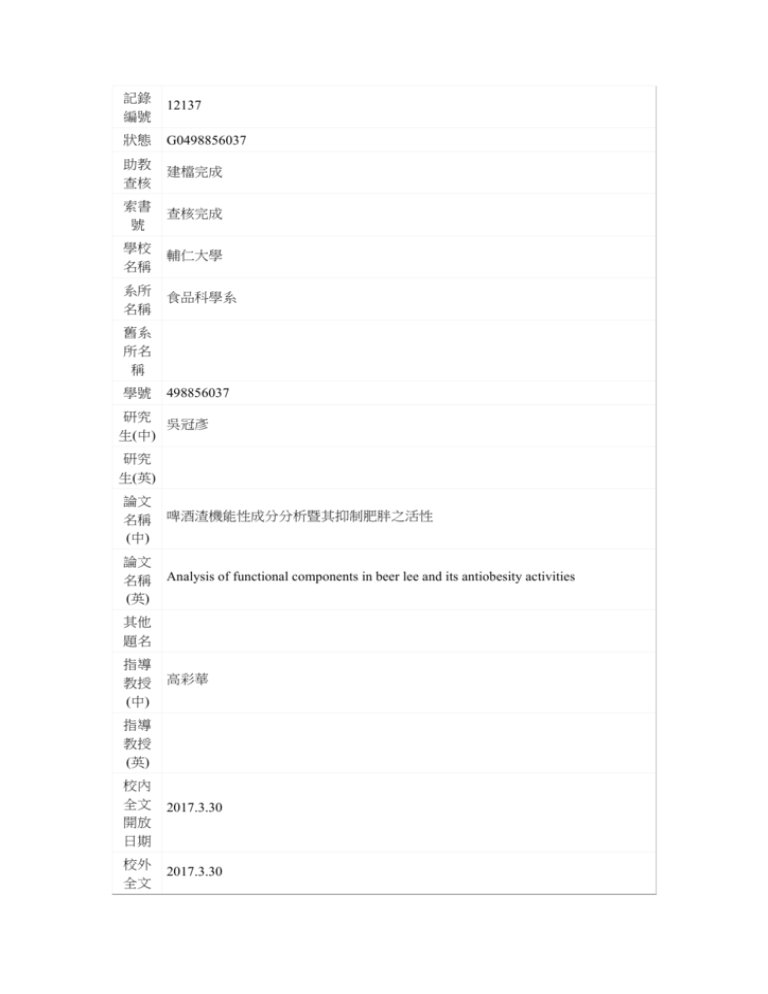
記錄 編號 12137 狀態 G0498856037 助教 查核 建檔完成 索書 號 查核完成 學校 名稱 輔仁大學 系所 名稱 食品科學系 舊系 所名 稱 學號 498856037 研究 吳冠彥 生(中) 研究 生(英) 論文 名稱 (中) 啤酒渣機能性成分分析暨其抑制肥胖之活性 論文 名稱 (英) Analysis of functional components in beer lee and its antiobesity activities 其他 題名 指導 教授 (中) 高彩華 指導 教授 (英) 校內 全文 開放 日期 2017.3.30 校外 全文 2017.3.30 開放 日期 全文 不開 放理 由 電子 全文 同意 送交 國圖. 國圖 全文 2017.3.30 開放 日期. 檔案 說明 全文 電子 全文 01 學位 類別 碩士 畢業 學年 度 100 出版 年 101 語文 別 中文 關鍵 啤酒渣 異戊烯類黃酮 啤酒花苦味酸 肥胖 3T3-L1 字(中) 關鍵 字(英) 摘要 (中) 啤酒是全球最普遍的酒精飲料之一並富含多種營養成分與機能性成分。 啤酒渣泛指啤酒釀造過程所產生的麥粕、啤酒花粕與酵母等副產物,一 般作為飼料或肥料。由於啤酒渣中機能性成分相關研究較為缺乏,因此 本研究目的即是先以高效液相層析儀分析啤酒渣中異戊烯類黃酮與啤酒 花苦味酸之種類與含量,並以 3T3-L1 細胞株探討啤酒渣萃取物對細胞 增生、細胞凋亡及脂肪生成之影響。結果顯示,使用 Thermo HyPURITY C18 管柱(150 mm × 4.6 mm I.D., 5 μm)搭配光電二極體陣列偵檢器,梯度 動相系統分別為磷酸水溶液(pH 1.6)及氰甲烷,以流速 1.5 mL/min 進行沖 提,檢測波長為 314 nm,可在 29 分鐘內同步分離 isoxanthohumol、 xanthohumol、8-prenylnaringenin 及 6-prenylnaringenin 4 種異戊烯類黃酮與 cohumulone、humulone、adhumulone、isocohumulone、isohumulone、 isoadhumulone、colupulone、lupulone 及 adlupulone 9 種啤酒花苦味酸。而 啤酒渣中則含有 isoxanthohumol、xanthohumol、8-prenylnaringenin、6prenylnaringenin、cohumulone、humulone、adhumulone、colupulone、 lupulone 及 adlupulone。在細胞增生方面,前驅脂肪細胞與脂肪細胞之存 活率隨著啤酒渣萃取物濃度的提升而下降,IC50 分別是 7.3 μg/mL 與 10.4 μg/mL。由流式細胞儀 annexin V-FITC/PI 雙染結果指出,啤酒渣萃 取物會促使成熟脂肪細胞凋亡,但並未造成前驅脂肪細胞凋亡。細胞週 期分析結果顯示,經啤酒渣萃取物處理後會使前驅脂肪細胞停滯於 G2/M 期,且細胞週期相關蛋白質 cyclin B1 顯著提升。在抑制脂肪生成 方面,在前驅脂肪細胞分化成脂肪細胞過程中添加啤酒渣萃取物,能有 效降低脂肪細胞數目及減少三酸甘油酯形成。 摘要 (英) 論文 目次 Beer is one of the main alcoholic beverages in the world, which is rich in nutrition and contains various functional compounds. Beer lee is a by-product generated from beer brewing and composed with spent grains, spent hops and surplus yeast, which have been used as cattle feed or fertilizer. However, studies of the amount of functional compounds in beer lee are rare. The objectives of this research are to analyze the content and variety of prenylflavonoid and hop bitter acid in beer lee by using high performance liquid chromatography, and to discuss the antiproliferation, apoptosis, and antiadipogenesis activity of 3T3-L1 cell line as affected by ethanol extract from beer lee. Results showed that 4 of prenylflavonoid and 9 of hop bitter acid can be separated simultaneously in 29 minutes by employing a Thermo HyPURITY C18 column (150 mm × 4.6 mm I.D., 5 μm) with the gradient solvent system of phosphoric acid in water (pH 1.6) and acetonitrile at flow rate 1.5 mL/min and detection wavelength at 314 nm. Moreover, the variety of these compounds can be identified as isoxanthohumol, xanthohumol, 8-prenylnaringenin, 6-prenylnaringenin, cohumulone, humulone, adhumulone, colupulone, lupulone and adlupulone in beer lee. In cell proliferation test, the preadipocyte and adipocyte viability decreased by increasing the concentration of beer lee extract and showed a 50% inhibition at 7.3 μg/mL and 10.4 μg/mL. Apoptosis analysis showed that beer lee extract increased the number of apoptotic cells in adipocyte, but not in preadipocyte by FITC-Annexin V/propidium iodine apoptosis flow cytometry. Cell cycle analysis revealed that treatment of preadipocyte with beer lee extract caused cell cycle arrest at the G2/M phase, and the cyclin B1 expression also shown to be up-regulated. During differentiation of 3T3-L1 preadipocytes to adipocytes, the beer lee extract efficiently reduced adipocyte number and the generation of intracellular triglyceride by oil red staining and triglyceride assay respectively. 第一章、緒言 1 第二章、文獻回顧 2 一、 啤酒渣簡介 2 (一) 麥粕 2 (二) 啤酒花粕 5 (三) 酵母 5 二、 啤酒渣中機能性成分 5 (一) 異戊烯類黃酮 8 (二) 啤酒花苦味酸 18 三、 肥胖簡介 33 (一) 成因 35 (二) 脂肪組織 35 (三) 3T3-L1 脂肪細胞株 35 第三章、材料與方法 39 一、 研究架構 39 二、 材料與儀器 40 (一) 原料 40 (二) 化學藥品 40 (三) 儀器設備 43 三、 實驗方法 45 (一) 啤酒渣之基本成分分析 45 (二) 啤酒渣異戊烯類黃酮及 啤酒花苦味酸成分分析 48 (三) 以細胞模式探討啤酒渣萃取液抑制肥胖之 活性 53 (四) 統計分析 64 第四章、結果與討論 65 一、 啤酒渣之組成 65 二、 HPLC 同步分析異戊烯類黃酮與啤酒花苦味酸方法之評估 65 (一) 偵 測波長之評估 65 (二) 管柱之評估 69 (三) 動相系統的發展 71 三、 波峰 成分鑑定 80 (一) 啤酒花苦味酸標準品波峰鑑定 80 (二) 樣品波峰鑑定 80 (三) 分析確效性評估 90 (四) 啤酒渣中異戊烯類黃酮與啤酒花苦味酸之含 量 93 四、 體外細胞模式探討啤酒渣萃取液抑制肥胖之效果 96 (一) 抑制 3T3-L1 細胞存活之影響 96 (二) 啤酒渣萃取物對凋亡之影響 100 (三) 啤酒 渣萃取物對細胞週期之影響 104 (四) 啤酒渣萃取物對脂肪生成之影響 107 第五章、結論 112 第六章、參考文獻 113 參考 文獻 吳輔祐。2009。肥胖與塑身生理學。第一版。藝軒圖書出版社。台北。 台灣。 AACC. 2000. Approved methods of analysis, 10th ed. American Association of Cereal Chemists, St. Paul, MN. Abelson P, Kennedy D. 2008. The obesity epidemic. Science 304: 1413. AOAC. 2000. Official methods of analysis, 17th ed. Association of Official Analytical Chemist. EUA. Avram MM, Avram AS, James WD. 2007: Subcutaneous fat in normal and diseased states 3. Adipogenesis: from stem cell to fat cell. J Am Acad Dermatol 56: 472-492. Bamforth CW. 2002. Nutritional aspects of beer-a review. Nutr Res 22: 227-237. Bartolomé B, Gómez-Cordovés C, Sancho AI, Dı́ez N, Ferreira P, Soliveri J, Copa-Patiño JL. 2003. Growth and release of hydroxycinnamic acids from Brewer’s spent grain by Streptomyces avermitilis CECT 3339. Enzyme Microb Tech 32: 140-144. Bays HE, Gonzalez-Campoy JM, Bray GA, Kitabchi AE, Bergman D A, Schorr AB, Rodbard HW, Henry RR. 2008. Pathogenic potential of adipose tissue and metabolic consequences of adipocyte hypertrophy and increased visceral adiposity. Expert ReV CardioVasc Ther 6: 343-368. Bertl E. Becker H. Eicher T. Herhaus C. Kapadia G. Bartsch H., Gerhäuser C. 2004. Inhibition of endothelial cell functions by novel potential anti-angiogenic agents. Biochem Biophys Res. Commun 325: 287-295. Bhumibhamon O. 1978. Production of acid protease and carbohydrate degrading enzyme by Aspergillus awamori. Thai J Agr Sci 11: 209-222. Briggs DE and Boulton CA, Brookes PA, Stevens R. 2004. Brewing science and practice. Woodhead Publishing, Cambridge. 963 p Callemien D, Collin S. 2010. Structure, organoleptic properties, quantification methods, and stability of phenolic compounds in beer-a review. Food Rev Int 26: 1-84. Casaschi A, Maiyoh GK, Rubio BK, Li RW, Adeli K, Theriault AG. 2004. The Chalcone Xanthohumol Inhibits Triglyceride and Apolipoprotein B Secretion in HepG2 Cells. J Nutr 134: 1340-1346. Č eslova L, Holč apek M, Fidler M, Drštič ková J, Lísa M. 2009. Characterization of prenylflavonoids and hop bitter acids in various classes of Czech beers and hop extracts using high-performance liquid chromatography-mass spectrometry. J Chromatogr A 1216: 7249-7257. Chae HJ, Joo H, In MJ. 2001. Utilization of brewer's yeast cells for the production of food-grade yeast extract. Part 1: effects of different enzymatic treatments on solid and protein recovery and flavor characteristics. Bioresource technol 76: 253-258. Chen L, Zhao Q, Jin H, Zhang X, Xu Y, Yu A, Zhang H, Ding L. 2010. Determination of xanthohumol in beer based on cloud point extraction coupled with high performance liquid chromatography. Talanta 81: 692-7. Chen WJ, Lin JK. 2004 . Mechanisms of cancer chemoprevention by hop bitter acids (beer aroma) through induction of apoptosis mediated by fas and caspase cascades. J Agric Food Chem 52: 55-64. Colgate EC, Miranda CL, Stevens JF, Bray TM, Ho E. 2007. Xanthohumol, a prenylflavonoid derived from hops induces apoptosis and inhibits NF-kappa B activation in prostate epithelial cells. Cancerletters 246: 201-9. Cowherd RM, Lyle RE. McGehee RE. 1999. Molecular regulation of adipocyte differentiation. Semin Cell Dev Biol 10: 3-10. Drenzek JG, Seiler NL, Jaskula SR, Rausch MM, Rose SL. 2011. Xanthohumol decreases Notch1 expression and cell growth by cell cycle arrest and induction apoptosis in epithelial ovarian cancer cell lines. Gynecol oncol 122: 396-401. Duvnjak Z, Budimir A, Suskovic J. 1983. Effect of spent grains from beer production on production of α-amylase by Bacillus subtilis 21+. Prehram Technol Rev 21: 97-101. Fruhbeck G, Gomez-Ambrosi J, Muruzabal FJ, Burrell MA. 2001. The adipocyte: a model for integration of endocrine and metabolic signaling in energy metabolism regulation. Am J Physiol Endocrinol Metab 280: E827-E847. Gerhauser C, Alt A, Heiss E, Gamal-Eldeen A, Klimo K, Knauft J, Neumann I, Scherf HR, Frank N, Bartsch H, Becker H. 2002. Cancer chemopreventive activity of xanthohumol, a natural product derived from hop. Mol Cancer Ther 1: 959-969. Gerhäuser C, Alt AP, Klimo K, Knauft J, Frank N, BeckerH. 2002. Isolation and potential cancer chemopreventive activities of phenolic compounds of beer. Phytochem Rev 1: 369-377. Gregoire FM, Smas CM, Sul HS. 1998. Understanding adipocyte differentiation. Physiol Rev 78: 783-809. Hall AJ, Babish JG, Darland GK, Carroll BJ, Konda VR, Lerman RH, Bland JS, Tripp ML. 2008. Safety, efficacy and anti-inflammatory activity of rho iso-alpha-acids from hops. Phytochemistry 69: 1534-1547. Haseleu G, Intekmann D, Hofmann. 2009. Identification and RP-HPLC-ESI-MS/MS quantitation of bitter-tasting ß-acid transformation products in beer. J agric chem 57: 7480-7489. Hermans-Lokkerbol ACJ and Verpoorte R. 1994. Development and validation of a high-performance liquid chromatography system for the analysis of hop bitter acids. J Chromatogra A 669: 65-73. Hofta P, Dostalek P, Sykora D. 2007. Liquid chromatography-diode array and electrospray highaccuracy mass spectrometry of iso-α-acids in DCHA-iso standard and beer. J inst brew 113: 48-54. Holtzel A, Schlotterbeck G, Albert K, Bayer E. 1996. Separation and characterization of hop bitter acids acids by HPLC-1H NMR coupling. Chromatographia 42: 499-505. Honma Y, Tobe H, Makishima M, Yokoyama A, Okabe-Kado. 1998. Induction of differentiation of myelogenous leukemia cells by humulone, a bitter in the hop. J Leuk Res 22: 605-610. Hougee S, Faber J, Sanders A, van den Berg WB, Garssen J, Smit HF, Hoijer MA. 2006. Selective inhibition of COX-2 by a standardized CO2 extract of humulus lupulus in vitro and its activity in a mouse model of zymosan-induced arthritis. Planta Med 72: 228-233. Huige NJ. 2006. Brewery by-products and effluents. In: Priest FG, Stewart GG (eds) Handbook of Brewing, 2nd edn. CRC Press, Boca Raton. Huszcza E and Bartmanska A. 2008. The implication of yeast in debittering of spent hops. Enzyme Microb Technol 42: 421-425. Intellmann D, Haseleu G, Hofmann T. 2009. LC-MS/MS quantitation of hop-derived bitter compounds in beer using the ECHO technique. J agric food chem 57: 1172-1182. Jaburek M, Varecha M, Gimeno RE, Dembski M, Jezek P, Zhang M, Burn P, Tartaglia LA, Garlid KD. 1999. Transport function and regulation of mitochondrial uncoupling proteins 2 and 3. J Bio Chem 274: 26003-26007. Jaskula B, Goiris K, Roucl GD, Aerts G, Cooman LD. 2007. Enhanced quantitative extraction and HPLC determination of hop and beer bitter acids. J Inst Brew 113: 381-390. Kersten S, Desvergne B, Wahli W. 2000. Roles of PPARs in health and disease. Nature 405: 421-424. Kondobeer K. 2004. Beer and health: preventive effects of beer components on lifestyle-related disease. Biofactors 22: 303-10 Krofta K, Poustka J, Hajšlová J. 2005. Bioactive substances in hops and beer. Hop Research Institut. Zatec , Czech Republic. Kuhbeck F, Muller M, Back W. 2007. Effect of hot trub and particle addition on fermentation performance of Saccharomtces cerevisiae. Enzyme Microb Technol 41: 711-20. Lamy V, Roussi S, Chaabi M, Gosse F, Schall N, Lobstein A,Raul F. 2007. Chemopreventive effects of lupulone, a hop ßacid, on human colon cancer-derived metastatic SW620 cells and in a rat model of colon carcinogenesis. Carcinogenesis 28: 1575-1581. Maddika S, Ande SR, Panigrahi S, Paranjothy T, Weglarczyk K, Zuse A, Eshraghi M, Manda KD, Wiechec E, Los M. 2007. Cell survival, cell death and cycle pathways are interconnected: implications for cancer therapy. Drug Resistance Updates 10: 1329. Magalhães PJ, Guido LF, Cruz JM, Barros AA. 2007. Analysis of xanthohumol and isoxanthohumol in different hop products by liquid chromatography-diode array detection-electrosprayionization tandem mass spectrometry. J Chromatogr A 1150: 295-301. Marjan VC, Cattoor K, Bosscher KD, Haegeman G, Keukeleire DD, Heyerick A. 2009. Hop (Humulus lupulus)derived bitter acids as multipotent bioactive compounds. J Nat Prod 72: 1220-30. McNeel RL and Mersmann HJ. 2003. Effects of isomers of conjugated linoleic acid on porcine adipocyte growth and differentiation. J Nutr Biochem 14: 266274. Milligan S, Kalita J, Pocock V, Heyerick A, De Cooman L, Rong H, De Keukeleire D. 2002. Oestrogenic activity of the hop phyto-oestrogen, 8prenylnaringenin. Reproduction 123: 235-42. Miranda CL, Stevens JF, Helmrich A, Henderson MC. 1999. Antiproliferative and cytotoxic effects of prenylated flavonoids from hops (Humulus Lupulus) in human cancer cell lines. Food Chem Toxicol 37: 271-85. Mussatto SI and Roberto IC. 2006. Chemical characterization and liberation of pentose sugars from brewer’s spent grain. J Chem Technol Biotechnol 81: 268-74. Mussatto SI. 2007. Biotechnological potential of brewing industry by-products. Biotechnology for agro-industrialresidues utilisation. Part III: 313-26. Namikoshi T, Tomita N, Fujimoto S, Haruna Y, Ohzeki M, Komai N, Sasaki T, Yoshida A, Kashihara N. 2007. Isohumulones derived from hops ameliorate renal injury via an anti-oxidative effect in Dahl salt-sensitive rats. Hypertens. Res 30: 175-184. Ntambi JM, Kim YC. 2000. Adipocyte differentiation and gene expression. J Nutr 130: 3122S-3126S. Nwinuka NM, Ibeh GO, Ekeke GI. 2005. Proximate composition and levels of some toxicants in four commonly consumed spices. J Appl Sci Environ Mgt 9:150-5. Peluso MR. 2006. Flavonoids attenuate cardiovascular disease, inhibit phosphodiesterase, and modulate lipid homeostasis in adipose tissue and liver. Exp Biol Med 231:128799. Pepper MS. Hazel SJ. Hümpel M. Schleuning WD. 2004. 8-prenylnaringenin, a novel phytoestrogen, inhibits angiogenesis in vitro and in vivo. J Cell Physiol 199: 98-107. Rayalam S, Yang JY, Dell-Fera, Park HJ, Ambsti S, Baile CA. 2009. Anti-Obesity Effects of xanthohumol plus guggulsterone in 3T3-L1 adipocytes. J Med Food 12: 847-53. Reichert M and Eick D. 1999. Analysis of cell cycle arrest in adipocyte differentiation. Oncogene 18: 459-466. Reinold MR. 1997. Manual pratico de cervejaria, first ed. Aden Editora e Comunicacoes Ltda, Sao Paulo. 214 p. Rong H, Zhao Y, Lazou K, De Keukeleire D, Milligan SR, Sandra P. 2000. Quantitation of 8-prenylnaringenin, a novel phytoestrogen in hops (Humulus lupulus L.), hop products, and beers, by benchtop HPLC-MS using electrospray ionization. Chromatographia 51: 545-551. Rosen ED, Walkey CJ, Puigserver P, Spiegelman BM. 2000. Transcriptional regulation of adipogenesis. Genes Dev 14: 1293-1307 Schaefer O. Hümpela M, Fritzemeier KH, Bohlmanna R, Schleuning WD.2003. 8-Prenylnaringenin is a potent ERα selective phytoestrogen present in hops and beer. J Steroid Biochem Mol Biol 84: 350-360. Schmitz I, Sabine K, Krammer PH. 2000. Regulation of death receptor-mediated apoptosis pathways. Int J Biochem Cell Biol 32: 1123-1136. Skoog DA, Holler FJ and Crouch SR. 2007. Principles of Instrumental Analysis. 6th Editor. Thomson Higher Education. Belmont, CA, USA. Stephan TE, Ngo EO, Nutter LM. 1998. Hexahydrocolupulone and its antitumor cell proliferation activity in vitro. Biochem pharmacol 55: 505-514. Stevens JF, Miranda CL, Frei B, Buhler DR. 2003. Inhibition of peroxynitrite-mediated LDL oxidation by prenylated flavonoids: The a,ß-unsaturated keto functionality of 2'-hydroxychalcones as a novel antioxidant pharmacophore. Chem res toxicol 16: 1277-1286. Stevens JF, Page JE. 2004. Xanthohumol and related prenylflavonoids from hops and beer: to you good health! Phytochemistry 65: 1317-30. Stevens JF, Taylor AW, Deinzer ML. 1999. Quantitative analysis of xanthohumol and related prenylflavonoids in hops and beer by liquid chromatography-tandem mass spectrometry. J Chromatogr A 832: 97-107. Talpur NA, Echard BW, Manohar V, Preuss HG. 2001. Influence of a combination of herbs on appetite suppression and weight loss in rats. Diabetes Obes Metab 3: 181-185. Tobe H, Kubota M, Yamaguchi M, Kocha T, Aoyagi T. 1997. Apoptosis to HL-60 by humulone. Biosci Biotechnol Biochem 61: 1027-1029. Vanhoenacker G, De Keukeleire D, Sandra P. 2004. Analysis of iso-α-acids and reduced iso-α-acids in beer by direct injection and liquid chromatography with ultraviolet absorbance detection or with mass spectrometry. J Chromatogr A 1035: 53-61. Wang D, Sakoda A, SuzukiM. 2001. Biological efficiency and nutritional value of Pleurotus ostreatus cultivated on spent beer grain. Bioresource technol 78: 293-300. Wang YW and Jones PJH. 2004. Conjugated linoleic acid and obesity control: efficacy and mechanisms. Int J Obes Relat Metab Disord 28: 941-955. Wise LS, Green H. 1979. Participation of one isozyme of cytosolic glycerophosphate dehydrogenase in the adipose conversion of 3T3 cells. J Biol Chem 254: 273-275. Yajima H, Ikeshima E, Shiraki M, Kanaya T, Fujiwara D, Odai H, Tsuboyama-Kasaoka N, Ezaki O, Oikawa S, Kondo K. 2004. Isohumulones, bitter acids derived from hops, activate both peroxisome proliferator-activated receptor α and γ and reduce insulin resistance. J Biol Chem 279: 33456-33462. Yamamoto K, Wang J, Yamamoto S, Tobe H. 2000. Suppression of cyclooxygenase-2 gene transcription by humulon of beer hop extract studied with reference to glucocorticoid. FEBS Lett 465: 103106. Yang JY, Della FMA, Rayalam SR, Baile CA. 2008. Ehanced effects of xanthohumol plus honokiol on apoptosis in 3T3-L1 adipocytes. Obesity 16: 12321238. Yang JY, Della-Fera MA, Rayalam S, Baile CA. 2007. Effect of xanthohumol and isoxanthohumol on 3T3-L1 cell apoptosis and adipogenesis. Apoptosis 12: 1953-63. Zhang X, Liang X, Xiao H, Xu Q. 2004. Direct characterization of bitter acids in a crude hop ectract by liquid chromatographyatmospheric pressure chemical ionization mass spectrometry. J Am Soc Mass Spectrom 15: 180-187 Zhang Y, Proenca R, Maffei M, Barone M, Leopold L, Friedman JM. 1994. Positional cloning of the mouse obese gene and its human homologue. Nature 372: 425-432. Zhao F, Nozawa H, Daikonnya A, Kondo K, Kitanaka S. 2003. Inhibitors of nitric oxide production from hops (Humulus lupulus L.). Biol Pharm Bull. 26: 61-65. Zhao F, Watanabe Y, Nozawa H, Daikonnya A, Kondo K, Kitanaka S. 2005. Prenylflavonoids and phloroglucinol derivatives from hops (Humulus lupulus). J Nat Prod 68: 43-49. 論文 頁數 附註 全文 點閱 次數 資料 建置 時間 2012/3/30 轉檔 日期 2012/03/30 全文 檔存 取記 錄 498856037 2012.3.30 10:25 140.136.182.103 new 01 異動 記錄 C 498856037 Y2012.M3.D30 10:23 140.136.182.103 M 498856037 Y2012.M3.D30 10:24 140.136.182.103 M fosc2513 Y2012.M3.D30 10:32 140.136.182.103 M FOSC2513 Y2012.M3.D30 11:43 140.136.174.68 M FOSC2513 Y2012.M3.D30 11:43 140.136.174.68 M FOSC2513 Y2012.M3.D30 11:43 140.136.174.68 I 030540 Y2012.M3.D30 13:03 140.136.208.63




